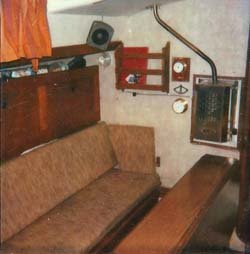- Home
- Choosing Accessories
- Boat Cabin Heater
Types of Boat Cabin Heater
For all but the hardiest of UK based sailors, a boat cabin heater is essential if your pride and joy is to be enjoyed year round. Not just for the warmth, but also to dispel the dampness that can pervade our boats in cold weather.
Boat cabin heaters fall into two distinct groups:~
Direct heating, where a stand-alone heater disperses warmth through the cabin by natural convection and radiation alone, and
Indirect heating, where heat from a remotely located unit is distributed throughout the boat by ducted hot air or hot water radiators, very much like a domestic central heating system.
There are options within each group; let's take a look at them...
Direct Heating Systems
Paraffin Fuelled Boat Cabin Heaters
I once owned a Nicholson 32 with a paraffin fuelled boat heater - a Taylor cabin heater - fitted in the saloon. It threw out great quantities of dry heat for a miserly usage of fuel. It was simple to maintain, and providing I did so regularly was never any trouble.
 the previous owner had installed it halfway up a bulkhead at the forward end of the saloon...
the previous owner had installed it halfway up a bulkhead at the forward end of the saloon...But the previous owner had installed it halfway up a bulkhead at the forward end of the saloon; there was just nowhere else for it to go.
As a result, my lower extremities would still be in the early stages of thawing out whilst parts above were toasting nicely.
Hardly the fault of the heater, but for best results they should be fitted closer to the cabin sole.
Like all boat cabin heaters of this type, it used a manually pressurised fuel tank to feed the paraffin to an 'Optimus' type burner, which had to be pre-heated by burning a small quantity of methylated spirits in a moat below it.
They use no electricity at all; if there was a fan club for them, I'd join.
Through Ventilation is Vital...
But burning paraffin, or any other hydrocarbon fuel for that matter, produces carbon dioxide and large amounts of water vapour, both of which must be vented to the atmosphere. Bulkhead mounted heaters of this type are vented to a mushroom exhaust cap on deck, and often incorporate a short chimney to improve the upward draft. Even so, there remains a risk.
Chimneys only work if the hot gas inside is sufficiently lighter than the surrounding air to create an upward draft. In cold weather the temptation is to close all ventilation hatches and portlights that face upwind.
With all the remaining vents and cowls facing downwind, the main hatch open and also acting as an exhaust, the pressure within the boat can be lower than that outside, and may be sufficient to reverse the flow of fumes in the chimney. The carbon dioxide will then gradually replace the oxygen in the cabin, and go on to produce carbon monoxide.
This is really nasty stuff; it's highly toxic, odourless, colourless and tasteless - and if it doesn't kill you, it can leave you permanently brain damaged.
The solution is to close the outlets in the ventilation system and open some of the inlets to maintain positive pressure in the cabin; then the chimney will work properly and you'll live to sail another day.
Even so, every boat should have one of these:
Diesel Fuelled Boat Cabin Heaters
Outwardly diesel fueled boat heaters are very similar to the paraffin types, but with some essential operational differences.
Gone is the need to pressurize the fuel tank; these units are drip fed from a gravity tank, which is either topped up manually or via an electrically pumped supply from the yacht's main fuel tanks.
Admittedly there's an added degree of complexity with the latter types, but the convenience is appealing and the power consumption is insignificant; around 0.25Ah per day.
Propane Fuelled Boat Cabin Heaters
I prefer to conserve my propane for the galley, so a propane cabin heater would not be my first choice.
But many owners, particularly those with smaller boats, speak highly of these types of cabin heaters.
As with the previous types, these produce water vapour and carbon dioxide so adequate ventilation is again absolutely essential.
This particular model incorporates two important safety features:~
- a thermocouple that provides instant shut-off if the flame is extinguished, and
- an oxygen depletion device which shuts off both the flame and the gas supply if the oxygen level in the cabin ever drops below 95% of the norm.
Solid Fuel Cabin Heaters
Maybe not as popular as they once were, probably owing the the convenience of paraffin, diesel and propane heaters, these nevertheless still have their devotees.
They will burn wood, charcoal and other solid fuels from which they produce a clean, dry heat.
Indirect Heating Systems
As with domestic central heating systems there are two types of Indirect Heating Systems in marine use - forced hot air (airtronic) and forced hot water (hydronic) systems.
In both cases diesel is drawn from the boats main fuel tanks and combusted in a sealed chamber located in an out-of-the-way space.
Exhaust gases are vented to the atmosphere, and the burners are microprocessor-controlled enabling automatic shutdown in the event of overheating.
Forced Hot Air Boat Cabin Heaters
With these, the burner draws combustion air from outside the boat as well as from inside, and burns it in a chamber with an air-to-air heat exchanger.
A blower unit then forces the heated air through flexible ducting to outlets in appropriate parts of the boat, which can be opened or closed as required.
A thermostat controls the temperature, turning the system on and off automatically.
But, conversely, airtronic systems can be used to cool the boat. In otherwise static conditions, with the heater switched off and the blower fans operating, fresh air will be distributed through the ducting.
And, if combined with an air conditioning unit, cooled air can be distributed around the boat.
Forced Hot Water Boat Cabin Heaters
The combustion parts of these systems are similar to the airtronic ones, but incorporate an air-to-water heat exchanger, the cooling water from which is pumped around the boat through a system of pipes and radiators.
The radiators are either convection type, or more commonly, fan-forced in much the same way as a car heater. The fan speed on each radiator can be adjusted manually, or controlled automatically by thermostats.
Whilst more complex and expensive than their airtronic cousins, the hot water systems do provide additional benefits:~
- They can be adapted to provide domestic hot water;
- They can be plumbed into the boat's engine (and generator) cooling water systems via a heat exchanger. Then, when underway and using the waste heat that would otherwise be lost, heater fuel consumption will be reduced. This also works in reverse, to preheat the engine and assist starting in cold climates.
Depending on size and the temperature setting, both types can be impressively extravagant with your electrical power.
Recent Articles
-
'The Dream', a Hallberg-Rassy 41 for Sale
Nov 07, 24 10:55 AM
This Hallberg-Rassy 41 is offered for sale in a transferrable marina slip in Oceanside San Diego California. -
The Nicholson 32 Mk10 Sailboat
Nov 02, 24 09:45 AM
Interested in the Nicholson 32 Mk10 sailboat? Here are the pics, specs and performance predictions you're looking for... -
Sailboat Cruising Tips for Beginners
Oct 29, 24 12:47 PM
Sailboat cruising offers an unparalleled sense of freedom and adventure. For beginners, however, it can seem daunting. This article provides essential tips to help you navigate the waters with confide…















